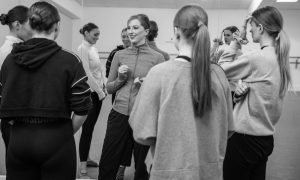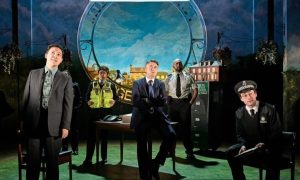Sadler’s Wells, London.
15 May 2025.
Northern Ballet’s production of Jane Eyre by Cathy Marston was sensational. Action and detail filled every corner and moment. An intense, lyrical score by Phillip Feeney carried us through the emotional story, whilst a highly imaginative moving set by Patrick Kinmonth portrayed the Yorkshire moors. Seamless scene changes contributed hugely to the continuous flow of action.
Marston has created a very special ballet with ingenious contemporary ballet choreography and staging. From the outset, as the prologue took us deep into the storyline with a distraught Jane tormented by the D-men, carried to St John’s home and cared for by his sisters, the storytelling was extremely clear. The link between the adult Jane of the prologue on the rostrum at the back of the stage and the childhood Jane on the main stage floor was exquisite. Adult Jane, danced by Sarah Chun, echoed the movements of childhood Jane – Mayuko Iwanaga – an effective technique used later in the ballet as well, clarifying they were both the same character at different stages in her life.
Adult Jane reflects on her past, beginning with the funeral of her parents. Gravestones are pushed forward on the stage by the D-men, surrounding childhood Jane. The choreography is very physical and reactive – Jane is teased and bullied by her cousins, turned on by her aunt when she retaliates and sent away to boarding school. Iwanaga displayed excellent internal strength as she portrayed Jane — bubbling inner turmoil, yet resolute and steely eyed on the outside as she stood on a stool as a punishment.
Marston said of casting the role of Jane, “I try to let go of how she’s physically described in the book, but rather find someone who has an inner strength, a rebellious side, but also a softness and vulnerability.” She certainly found this in both Iwanaga and Chun.
I felt unsure about the inclusion of the D-men before the production began. The D-men represent what ‘men’ are to Jane. She meets with much torment and intimidation from men in her life and has to work hard to overcome this.
“I wanted to give them an elemental feel when they move as a group – almost like a storm gathering over the moors,” noted Marston.
The D-men in performance were an incredible addition. In some respects, they had a similar role to a corps de ballet. They moved together a lot of the time, provided background, depth and storyline escalation. At one point, they were the candles Jane blew out on her way to bed, and at another, they were her ‘wardrobe’ assisting with her onstage costume changes – flawless.
As her troubled thoughts descended whenever she was alone, the D-men swirled around Jane with powerful movement, physically lifting and rolling her between them. She made such effort to push them away each time they bore down on her.
Mr Rochester, making his entrance, had more jollity and charisma about him than perhaps was expected. But it worked, and the instantaneous magnetic pull between him and Jane was both charming and amusing to watch, as he teased her and she worked out how to tease back.
Their romance escalated fast, and the wedding scene was so satisfying to watch in its slick and clean execution. Rochester, danced by Jonathon Hanks, reverently carried a white dress across the stage and Jane appeared on stage wearing it. All to the fluster of the very entertaining housekeeper Mrs Fairfax, characterised by her fast bourrée and clasping of hands, danced by Heather Lehan.
The wedding ceremony progressed, watched by an excited Adele – Aerys Merrill, who portrayed Adele’s childish innocence delightfully. Bertha, Rochester’s insane wife crept in, and a wild, almost comical scene played out with Rochester repeatedly attempting to keep her from interrupting the ceremony and then placing his hand over Jane’s to complete their vows.
Jane, on inevitably discovering his betrayal, is inconsolable. The prologue scene is repeated here, with Jane rescued by St John, played by Albert González Orts. Satisfying to recognise its place in the story, and very apparent, having already seen Jane and Rochester’s mutual attraction, that there is none with St John.
The fire scene at Thornfield, initiated by Bertha, played by Gemma Coutts, was extremely well-staged and included a dramatic and highly physical duet between the two, ending in Rochester losing his sight and Bertha her life.
Jane eventually returns to Rochester. Their duet here, with Rochester injured and sightless, showed much more equality between them. Now it is Jane reaching out for and supporting him. She initiated their teasing and game-playing this time, bringing a smile to his – to both of their faces.
The ending was spine-tingling. Jane stepped away from her embrace with Rochester and walked towards the audience, chin held high. She never lost who she was for a moment. Beautiful.
By Louise Ryrie of Dance Informa.














